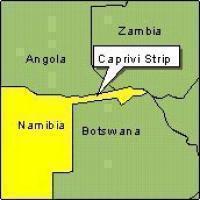







|
News and Information
Food shortages loom in Caprivi
| July 8, 2005 |

*LINDSAY DENTLINGER
CAPRIVIANS could go hungry this year: coarse grain production is forecast to have dropped by 76 per cent from last season, Government's Namibia Early Warning and Food Information Unit (Newfiu) has warned.
"The failure of this season's maize crop could have disastrous consequences for [the] Caprivi region's food security," says the Crop Assessment report released on Wednesday.
Overall, the report anticipates Namibia's food situation to be "tight, particularly in the Caprivi".
In general, poor rains and the late planting of crops will result in a below-average harvest this year and even further production declines of about 20 per cent during 2005-06.
Newfiu forecasts a 16 per cent drop in the country's overall harvest this year compared to last year, to an amount below the eight-year average.
The aggregate course grain (millet, sorghum and maize) crop for 2004-05 has been provisionally forecast at 97 182 tonnes.
But Government is confident that the deficit of 81,7 tonnes for the period between May 2005 and April 2006 will be adequately met by commercial imports.
Unlike in private production, commercial areas in Namibia expect a good harvest - about 48 per cent above last year's production.
"Although the commercial stocks appear adequate at the national level to meet the country's consumption needs, localised deficits will persist, due to adverse growing conditions," the report says.
The marked drop in cereal production from the earlier March forecast is mostly attributed to severe dry spells experienced over most of the country - especially in the Caprivi.
Constituencies in the eastern Caprivi will be the worst off because of a near-total failure of their maize crop, the report says.
Because of the late start of the rains in the Caprivi, only half the area was planted this season compared to the previous year.
The total production of coarse grain in the region is forecast at 2 107 tonnes.
The outlook for the next season is also grim for the Caprivi - with a seed shortage envisaged because of the poor harvest.
Grazing conditions are currently favourable, says Newfiu, but are expected to deteriorate.
"Close monitoring of the household food security situation is recommended," advises Newfiu.
The forecast comes at a time when the Caprivi Emergency Management Unit is embroiled in a scandal for failing to deliver 230 tonnes of maize and other food aid to flood victims.
A team sent by the Prime Minister's Office to investigate the situation was scheduled to finalise the report of its findings last night.
In the Kavango, Omusati, Oshana, Ohangwena and Oshikoto regions, yields of early-planted crops have also been reduced because of consistent dry periods, while crops that were planted late failed to reach maturity when the rains ended abruptly.
Although the rains fell early throughout most of the country, except in the Caprivi, the long, dry spell during most of December, and the subsequent irregular and below-average pattern, affected crop production.
All the good rains fell in January; they ended abruptly at the end of March, which prevented crops from reaching maturity.
The national food supply situation for the 2005-06 season also does not look favourable.
The cereal harvest is expected to be 20 per cent lower than this year, at only 107 682 tonnes.
Together with operating stocks, the total domestic supply is expected to be 157 682 tonnes - putting the import requirement at 149 590 tonnes.
This is calculated assuming a population figure of 2,08 million and an average per capita cereal consumption of 125 kg a year.
The final estimates of the 2004-05 harvest will be available after the National Planning Commission finalises the results of the current Agricultural Census. |
Source: www.namibian.com.na |
| http://www.namibian.com.na/ |
|
| Support Caprivi Freedom |
Fill out the form below to become a member of this site and receive our regular newsletter.
|

|

